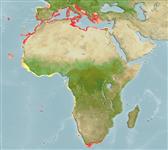Common names from other countries
Environment: milieu / climate zone / depth range / distribution range
Ekologi
; kisaran kedalaman 1 - 110 m (Ref. 85345). Subtropical; 46°N - 37°S, 26°W - 32°E
Eastern Atlantic and the Mediterranean.
Length at first maturity / Size / Weight / umur
Maturity: Lm ? range ? - ? cm Max length : 60.0 cm WD jantan/; (Ref. 114251)
Maximum length is in body diameter (Ref. 114251). Infaunal; found on sandy substrates (Refs 106821, 106822). Common on bottoms covered with seagrasses and also occurs on detritic and muddy bottoms (Ref. 106822). Main diet include gastropods and bivalves (Ref. 106164).
Life cycle and mating behavior
Kematangan | Reproduksi, perkembang biakan | Pemijahan | telur-telur | Fecundity | Larva
Members of the class Asteroidea exhibit both asexual (regeneration and clonal) and sexual (gonochoric) means of reproduction. Life cycle: Embryos hatch into planktonic larvae and later metamorphose into pentamorous juveniles which develop into young sea stars with stubby arms.
rujukan utama
Acuan | Koordinator | mitra
MarineSpecies.org. 2050. (Ref. 3477)
Status IUCN Red List (Ref. 130435)
status CITES (Ref. 108899)
Not Evaluated
Not Evaluated
ancaman kepada manusia
Harmless
penggunaan manusia
| FishSource |
Alat, peralatan
informasi lanjut
Umur / Saiz
Pertumbuhan
panjang-berat
panjang-panjang
Morfologi
Larva
Kelimpahan
Sumber internet
Estimates based on models
Preferred temperature
(Ref.
115969): 14.3 - 21, mean 18.2 (based on 276 cells).
